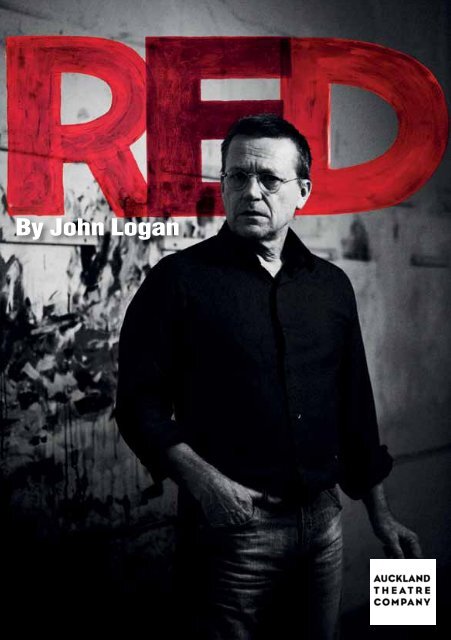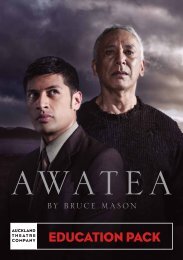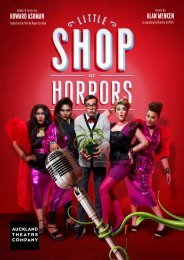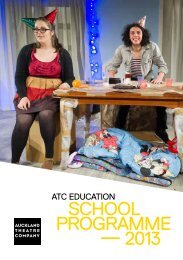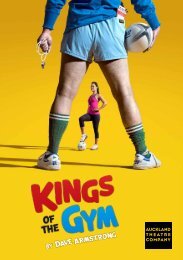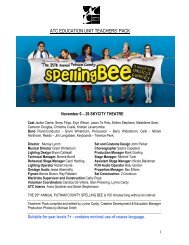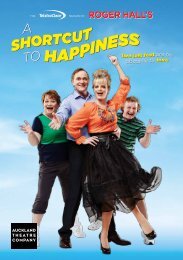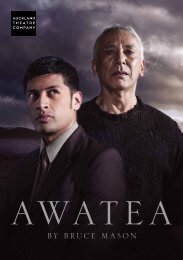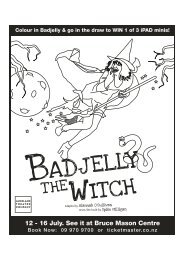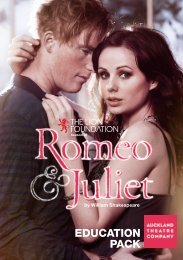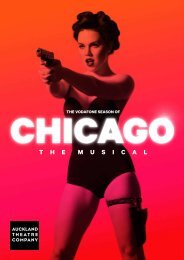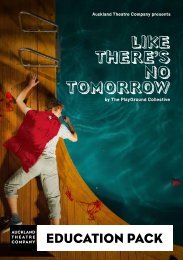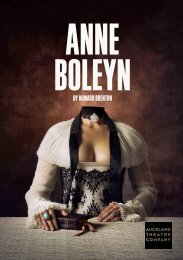You also want an ePaper? Increase the reach of your titles
YUMPU automatically turns print PDFs into web optimized ePapers that Google loves.
<strong>By</strong> <strong>John</strong> <strong>Logan</strong>
principal funDers<br />
cOre funDers preMier partner<br />
MajOr prOject partners<br />
MajOr suppOrters<br />
MeDia partners<br />
Proud to be NZ’s Most Awarded<br />
Winery and Sponsor of <strong>Auckland</strong><br />
<strong>Theatre</strong> <strong>Company</strong><br />
suppOrting partners<br />
Official caterers of <strong>Auckland</strong><br />
<strong>Theatre</strong> <strong>Company</strong><br />
bka interactive / bDO aucklanD / canOn<br />
M.a.c. cOsMetics / Marketing iMpact / WaiWera Water<br />
MaiDMent theatre / the eDge / Q theatre<br />
WeLcome<br />
Welcome to the New Zealand<br />
premiere of <strong>John</strong> <strong>Logan</strong>’s<br />
RED, the fourth play in our<br />
2011 Territories of the Heart<br />
season. The subject of this<br />
Tony Award-winning play is<br />
Mark Rothko – one of the<br />
most important painters of<br />
post World War II modernism.<br />
In fact one of Rothko’s works<br />
still holds the record for the<br />
highest priced sale at auction<br />
of any post World War II<br />
painter — $US72 million.<br />
Mark Rothko was one<br />
of a group of artists,<br />
loosely labelled Abstract<br />
Expressionists. Since the<br />
late nineteenth century Paris<br />
had been the centre of the<br />
Art World, which had been<br />
dominated by European<br />
currents. But Rothko and his<br />
colleagues (who included<br />
Willem De Kooning and<br />
Jackson Pollock) put paid<br />
to that; they were the first<br />
American artists to receive<br />
truly international recognition.<br />
<strong>By</strong> all accounts Rothko was<br />
a difficult man: intense and<br />
intensely private, fiercely<br />
intellectual, serious and totally<br />
dedicated to his work. He<br />
said, “I am interested only<br />
in expressing basic human<br />
emotions – tragedy, ecstasy,<br />
doom, and so on. And the<br />
fact that people break down<br />
and cry when confronted<br />
with my pictures shows that<br />
I can communicate those<br />
basic human emotions. The<br />
people who weep before my<br />
paintings are having the same<br />
religious experience I had<br />
when I painted them”.<br />
Not the easiest character to<br />
recreate on stage then. But<br />
playing difficult artists is not<br />
strange territory to Michael<br />
Hurst, one of our finest actors;<br />
he’s already played Charles<br />
Goldie and Toulouse Lautrec.<br />
Joining Michael onstage in his<br />
<strong>Auckland</strong> <strong>Theatre</strong> <strong>Company</strong><br />
debut is Elliot Christensen-<br />
Yule – who brings a great<br />
sensitivity and his own unique<br />
style the role of Ken. My huge<br />
thanks to them both.<br />
Big thanks too to our stellar<br />
creative team: director Oliver<br />
Driver, set and costume<br />
designer <strong>John</strong> Parker, lighting<br />
designer Brad Gledhill (who so<br />
loved the play when he saw<br />
it on Broadway, he begged<br />
me to let him light it for us!);<br />
sound designer Claire Cowan<br />
and Paul Pachter for his<br />
Rothko reproductions.<br />
So we invite you into Rothko’s<br />
studio – and into one of the<br />
great minds and talents of<br />
20th century modernism.<br />
Enjoy!<br />
Colin McColl
cast<br />
Rothko – Michael Hurst Ken – Elliot Christensen-Yule<br />
creative<br />
Director – Oliver Driver Set & Costume Design – <strong>John</strong> Parker<br />
Lighting Design – Brad Gledhill Sound Design – Claire Cowan<br />
Painting Coach and Rothko Reproductions – Paul Pachter<br />
<strong>By</strong> <strong>John</strong> <strong>Logan</strong><br />
production<br />
Production Manager – Mark Gosling Technical Manager – Paul Nicoll<br />
Senior Stage Manager – Fern Christie Stage Manager – Gabrielle Rhodes<br />
Technical Operator – Rochelle Houghton Properties Master – Diana Kovacs<br />
Wardrobe Supervisor – Sophie Ham Set Construction – 2 Construct<br />
Rehearsal Photography – Amber McWilliams ASB Community Trust Emerging Artist<br />
Apprentice –Jessika Verryt<br />
RED premiered at the Donmar Warehouse <strong>Theatre</strong>, London (3 December 2009). Michael Grandage, Artistic Director<br />
Original Broadway Production Produced by Arielle Tepper Madover, Stephanie P. McClelland, Matthew <strong>By</strong>am Shaw,<br />
Neal Street Productions, Fox Theatricals, Ruth Hendel/Barbara Whitman, Philip Hagemann/<br />
Murray Rosenthal and The Donmar Warehouse.<br />
AUCKLAND THEATRE COMPANY WOULD LIKE TO THANK THE FOLLOWING FOR THEIR HELP WITH THIS PRODUCTION:<br />
Linda Tyler, Amber Older, Richard Thomson, Robin Richmond, Corinna Lotz, A World To Win, Richard Jeffery, Cole Jenkins,<br />
International Art Centre, Mark Castle at the French Art Shop, Regina McMenamin at The Four Seasons.<br />
RED is the fourth <strong>Auckland</strong> <strong>Theatre</strong> <strong>Company</strong> production for 2011 and opened on June 2nd.<br />
RED is approximately 90 minutes long. Please remember to switch off all mobile phones, pagers and watch alarms.<br />
“We have Art that we may not<br />
perish from Truth” – Goya.<br />
I have worked with Michael<br />
Hurst many times throughout<br />
my career and there was<br />
nobody else in my mind who<br />
could capture Rothko. My<br />
thanks to him for allowing<br />
me to bully him into taking on<br />
this role and for working so<br />
hard with me to create the<br />
play you will see tonight. I<br />
saw many young actors while<br />
searching for Ken but Elliot<br />
stood out from his very first<br />
audition; there was something<br />
eminently watchable about<br />
him and luckily he is as hard<br />
and fast a worker as both<br />
Michael and I, which is no<br />
mean feat I can assure you.<br />
A play stands or falls on its<br />
casting and I could not be<br />
happier with my wonderful<br />
little cast.<br />
Working with <strong>John</strong> Parker<br />
for the first time as a director<br />
has been an absolute treat.<br />
We wanted to take you inside<br />
Rothko’s studio, to recreate<br />
it as closely as we could, and<br />
<strong>John</strong> has managed to make<br />
you feel as if you really are<br />
transported back to the 50s,<br />
hiding in Rothko’s studio,<br />
eavesdropping on history.<br />
You can’t do a play about<br />
Rothko without seeing his<br />
work up on stage and I thank<br />
God for New Zealand artist<br />
Paul Pachter, who not only<br />
recreated some of Rothko’s<br />
works for us but taught us all<br />
about painting and painters.<br />
This production would not be<br />
what it is if he had not turned<br />
our rehearsal rooms into an<br />
actual painter's studio.<br />
DIRecToR’S<br />
NoTeS<br />
Rothko loved music and the<br />
play calls for a sound design<br />
that not only stays true<br />
to the music he loved but<br />
also underscores the story<br />
unfolding onstage.<br />
Claire Cowan has created<br />
a soundtrack Rothko would<br />
be proud of.<br />
Thanks also to my Stage<br />
Manager Gabrielle; this is her<br />
show now and I know it is in<br />
the safest of hands.<br />
Finally, my heart felt thanks<br />
to Colin McColl for letting<br />
me direct this wonderful<br />
production. It has been an<br />
awfully long time since I<br />
worked for <strong>Auckland</strong> <strong>Theatre</strong><br />
<strong>Company</strong> but it’s good to<br />
be back.<br />
Oliver Driver<br />
Director
SYNoPSIS<br />
1950s New York. In<br />
the dimly-lit sanctum<br />
of the artist’s studio,<br />
abstract expressionist<br />
painter Mark Rothko<br />
drinks, smokes and<br />
works. His project:<br />
a series of enormous<br />
red murals to grace<br />
the walls of a new<br />
restaurant in the<br />
Seagram Building.<br />
Into this carefully controlled<br />
environment comes Rothko’s<br />
new assistant, Ken, bringing<br />
with him Chinese takeaways,<br />
his own aspirations, and<br />
a new perspective on the<br />
changing outside world.<br />
Layer by layer the foundations<br />
of the paintings – and the<br />
relationship – are laid.<br />
Rothko’s rants and revelations<br />
are punctuated and proved by<br />
Ken’s insights. The past and<br />
future are brought together<br />
in the deepening hues that<br />
demonstrate the meaning of<br />
tragedy for both men.<br />
As Rothko’s contemplations<br />
on canvas draw near<br />
completion, Ken begins<br />
to challenge the painter’s<br />
assumptions about his<br />
assistant and his art. Reading<br />
between the rough lines of<br />
colour, much is revealed about<br />
the messy art of living.<br />
deveLoPed<br />
And toured<br />
<strong>By</strong> te PAPA<br />
Brian Brake<br />
Lens on the World<br />
1 June to 14 August<br />
free Admission<br />
<strong>Auckland</strong> Art Gallery<br />
Toi o Tāmaki<br />
open daily 10am–5pm<br />
Corner Wellesley and Lorne streets<br />
www.aucklandartgallery.com<br />
Brian Brake (1927–1988) Monsoon girl from<br />
the series: monsoon, 1960, india. gift of<br />
mr raymond Wai-man Lau, 2001, te Papa
ReHeARSALS
mARK RoTHKo<br />
(1903–1970)<br />
<strong>By</strong> Linda Tyler<br />
The name<br />
Mark Rothko<br />
is synonymous<br />
with Abstract<br />
Expressionism,<br />
an American art<br />
movement of the<br />
mid twentieth<br />
century, which<br />
deftly shifted the<br />
centre of artistic<br />
influence from<br />
Paris to New York,<br />
just in time for the<br />
Cold War.<br />
Both in America and abroad,<br />
Rothko was the most widely<br />
acclaimed and exhibited<br />
artist of the New York<br />
School. Soaking his huge<br />
vertical format canvases with<br />
thinned oil paint applied in<br />
parallel rectangular blocks<br />
with softened edges – bright<br />
oranges, yellows, reds and<br />
magenta – he created whole<br />
environments of colour.<br />
Painting on a huge scale, he<br />
overwhelmed his viewers,<br />
who were used to physically<br />
controlling their encounters<br />
with art by walking up to<br />
something encased in a<br />
frame, inspecting it and<br />
then moving away. Rothko’s<br />
paintings were nearly three<br />
metres in height and over two<br />
metres wide, engendering in<br />
the viewer a sense of being<br />
suspended in space and<br />
immersed in the experience<br />
of the colour. “I paint large<br />
pictures because I want to<br />
create a state of intimacy. A<br />
large picture is an immediate<br />
transaction: it takes you into it.”<br />
Rothko endured financial<br />
hardship for most of his life.<br />
He was the youngest of four<br />
children born in 1903 to Jakob<br />
Rothkovich, a pharmacist,<br />
and his wife Anna. As eight<br />
year old Marcus Rothkowitz,<br />
he emigrated from Dvinsk in<br />
Russia to Portland, Oregon<br />
in 1913. Seven months later<br />
his father died suddenly,<br />
and the ensuing poverty<br />
meant that Rothko had to<br />
get a newspaper delivery<br />
round to pay his school fees.<br />
An outstanding student,<br />
he graduated high school<br />
aged seventeen, and won a<br />
scholarship to Yale, which<br />
was offered as a loan rather<br />
than a grant because of<br />
anti-Semitism.<br />
Undeterred, he paid his way<br />
through college, but dropped<br />
out in 1923 after only two<br />
years and found work in the<br />
garment district in New York<br />
as a pattern cutter. Painting<br />
classes at the Art Students’<br />
League qualified him to<br />
become the art teacher at the<br />
Central Academy in Brooklyn,<br />
a parochial school attached<br />
to a synagogue in 1929. His<br />
teaching career was to sustain<br />
him for the next thirty years.<br />
Rothko’s first solo exhibition at<br />
the aptly-named Opportunity<br />
Gallery in New York was also<br />
in 1929. Two more shows<br />
followed in the early years of<br />
the Great Depression – one<br />
in New York and the other<br />
in Portland, Oregon and<br />
these qualified him for work<br />
with the Federal Art Project.<br />
While his marriage to jeweller<br />
Edith Sacher around this<br />
time was not a success, his<br />
weekly salary of $23.50 in<br />
the easel-painting division of<br />
the FPA sustained the couple<br />
financially.<br />
Work at the FPA brought<br />
him into contact with Adolph<br />
Gottlieb, with whom he<br />
founded “The Ten”, a group<br />
of Expressionist artists who<br />
exhibited regularly together<br />
in New York, and even once<br />
in Paris. His painting shifted<br />
from dreamy Surrealist<br />
landscape themes to images<br />
of idealised Greek gods<br />
and goddesses and archaic<br />
symbols. He explained this<br />
change in subject matter<br />
thus: “Greek myths are the<br />
eternal symbols to which<br />
we must fall back to express<br />
basic psychological ideas.<br />
They are the symbols of<br />
man’s primitive fears and<br />
motivations, no matter which<br />
land or what time… And<br />
modern psychology finds them<br />
persisting still in our dreams,<br />
our vernacular, and our art,<br />
for all the changes in outward<br />
conditions of our life.” In 1938<br />
he received his citizenship<br />
papers and two years later<br />
officially shortened his name to<br />
Rothko. Soon after he divorced<br />
Edith and married Mary Alice<br />
(Mell) Beistle, a children’s book<br />
illustrator ten years his junior.<br />
At the end of WW2, Peggy<br />
Guggenheim presented<br />
Rothko’s recent work in a<br />
solo show at her ‘Art of This<br />
Century Gallery’. When that<br />
gallery closed, Betty Parsons<br />
became his New York dealer<br />
while he lived in California and<br />
taught at the California School<br />
of Fine Arts in San Francisco.<br />
His daughter Kate, was born<br />
in 1950 and the family moved<br />
back to New York, where he<br />
was mocked by the bohemian<br />
painters who inhabited the<br />
lofts of Greenwich Village.<br />
Despite this, his friendship<br />
with Alfred Barr, Director<br />
of the Museum of Modern<br />
Art, paid off hugely when<br />
Barr persuaded the architect<br />
Philip <strong>John</strong>son to donate a<br />
Rothko painting to MOMA.<br />
But the critical endorsement<br />
of his work didn’t leverage into<br />
sales, and financial pressures<br />
led him to return to full-time<br />
teaching. After a stint at Tulane<br />
University in New Orleans, the<br />
Rothko’s returned permanently<br />
to New York where a son,<br />
Christopher, was born in 1963.<br />
Rothko was caustic in<br />
his criticism of public art<br />
institutions. He had been<br />
included in the Whitney<br />
Annual, an important public<br />
gallery survey in 1945,<br />
but had little respect for<br />
the Whitney curators. He<br />
refused to be in the 1947<br />
Annual, saying that he had<br />
no wish to be shown “next<br />
to mediocrity”. In 1952<br />
he vetoed the sale of two<br />
paintings to the Whitney,<br />
which he referred to privately<br />
as “a junkshop”. That year,<br />
he also fell out with Dorothy<br />
Miller, curator of Fifteen<br />
Americans, a group exhibition<br />
at the Museum of Modern Art<br />
by sending her many more<br />
paintings than those she had<br />
chosen, and interfering with<br />
the installation of the works.<br />
His relationships were better
with West Coast public art<br />
museums: the San Francisco<br />
Museum of Art and the<br />
Santa Barbara Museum had<br />
shown his works from the<br />
late 1940s which were based<br />
on images of the New York<br />
subway — paintings he later<br />
referred to as “images from<br />
a tableau vivant of human<br />
incommunicability”.<br />
<strong>By</strong> 1947 the Surrealistic<br />
seascapes, subway scenes<br />
and Greek myths disappeared<br />
and Rothko launched what<br />
would become known as his<br />
mature style: abstractions<br />
with floating blocks of pure<br />
colour which lifted viewers<br />
away from the sights and<br />
sounds of modern life into a<br />
meditative space. The thinlypainted,<br />
radiant surfaces<br />
were reminiscent of the<br />
watercolours which he had<br />
painted in the 1930s, and he<br />
described this classic style<br />
as “the simple expression<br />
of complex thought”. While<br />
his reputation and his<br />
earning power grew steadily<br />
throughout the 1950s,<br />
Rothko’s competitiveness<br />
soured old friendships and he<br />
earned a reputation as selfcentred,<br />
temperamental and<br />
ambitious. Barnett Newman<br />
was incensed when Rothko<br />
claimed that he had taught<br />
him how to paint, and Jackson<br />
Pollock was offended by<br />
Rothko’s dismissal of<br />
Blue Poles during a private<br />
studio visit.<br />
Selection as the American<br />
representative at the Venice<br />
Biennale with Mark Tobey in<br />
1958 fed his ambition, and<br />
three years later a full-scale<br />
retrospective of Rothko’s work<br />
was curated at the Museum<br />
of Modern Art. Three<br />
challenging commissions<br />
to paint murals followed. In<br />
1958, his forty red and brown<br />
paintings in three series for<br />
the Mies van der Rohe and<br />
Philip <strong>John</strong>son-designed<br />
Seagram Building on Park<br />
Avenue in New York were<br />
conceived, not as individual<br />
works, but as a coordinated<br />
installation complementary<br />
to the vertical architectural<br />
features of the interior. He<br />
later claimed that his aim with<br />
the Seagram murals was to<br />
paint “something that will<br />
ruin the appetite of every<br />
son-of-a-bitch who ever eats<br />
in that room” – the luxury<br />
Four Seasons restaurant. In<br />
the end, he decided to return<br />
Seagram’s money and keep<br />
the paintings himself on the<br />
grounds that the setting was<br />
too pretentious for his work.<br />
Subsequent commissions<br />
for murals from Harvard<br />
University and the St Thomas<br />
chapel in Houston meant that<br />
he no longer had financial<br />
worries. His new threat<br />
was the beginnings of Pop<br />
Art, whose practitioners he<br />
declared were “charlatans and<br />
opportunists…who are out<br />
to murder us”. In the spring<br />
of 1968 he was diagnosed<br />
with an aortic aneurysm,<br />
which exacerbated his already<br />
morbid depression and made<br />
him impotent. He began<br />
drinking heavily and taking<br />
both barbiturates and antidepressants.<br />
Friends of the<br />
Rothko’s recall the drunken<br />
brawling that preceded his<br />
desertion of his wife on<br />
New Year’s Day in 1969.<br />
The creation of his seemingly<br />
tranquil paintings had come at<br />
huge cost.<br />
The unhappy circumstances<br />
of the last year of his life<br />
resulted in radical departures<br />
in Rothko’s art. His doctor had<br />
told him not to work on any<br />
surface larger than a yard in<br />
height, so he turned to work<br />
on paper, producing a series<br />
of dazzling acrylics. Dividing<br />
the picture into two unequal<br />
rectangular areas of uniformly<br />
luminous colour, he produced<br />
a separate series of small<br />
Seagram Murals, Rothko Room —<br />
Seven Murals, 1958<br />
Interior Chiba-Ken, Japan, Kawamura<br />
Memorial Museum of Art<br />
black and grey canvases with<br />
stark white borders. Yet even<br />
these successes could not<br />
appease his dissatisfaction<br />
with life. Edward Lucie-Smith<br />
described his death, which<br />
was achieved by slashing the<br />
veins inside the crooks of his<br />
own arms on 25 February<br />
1970, as “a messy end to<br />
an intolerably miserable<br />
existence”.<br />
Research Partner with<br />
<strong>Auckland</strong> <strong>Theatre</strong> <strong>Company</strong><br />
Linda Tyler is the Director at<br />
the Centre for New Zealand<br />
Art Research and Discovery.
cAST<br />
mIcHAeL<br />
HURST<br />
In a career spanning more than<br />
three decades, Michael has<br />
become one of New Zealand’s<br />
leading actors and directors.<br />
His theatre credits include<br />
AMADEUS, Riff-Raff in THE<br />
ROCKY HORROR SHOW<br />
and Widow Twankey in his<br />
own version of ALADDIN.<br />
His musical roles include<br />
Koko in THE MIKADO, Judge<br />
Turpin in SWEENEY TODD,<br />
Macheath and Tiger Brown in<br />
THE THREEPENNY OPERA,<br />
King Herod in JESUS CHRIST<br />
SUPERSTAR and the Emcee<br />
in three productions of<br />
CABARET.<br />
Michael is also renowned<br />
for his interpretations of<br />
Shakespeare, including<br />
HAMLET, MACBETH,<br />
RICHARD III, Touchstone<br />
in AS YOU LIKE IT and The<br />
Fool in KING LEAR. In 1993<br />
Michael was cast in the role of<br />
Iolaus and co-starred in the US<br />
television series HERCULES<br />
— THE LEGENDARY<br />
JOURNEYS, which ran for<br />
eight years and played to a<br />
world-wide audience.<br />
Directing credits include<br />
CABARET, SHE STOOPS<br />
TO CONQUER, HAMLET,<br />
MACBETH, KING LEAR,<br />
TWELFTH NIGHT, THE<br />
THREEPENNY OPERA,<br />
LOOT and HAPPY DAYS.<br />
He has also directed many<br />
episodes of the US television<br />
series HERCULES — THE<br />
LEGENDARY JOURNEYS,<br />
XENA — WARRIOR<br />
PRINCESS, SPARTACUS<br />
— BLOOD AND SAND and<br />
SPARTACUS — GODS OF<br />
THE ARENA as well as the<br />
NZ feature film JUBILEE.<br />
Michael was a founding<br />
member of <strong>Auckland</strong>’s<br />
Watershed <strong>Theatre</strong> in 1990,<br />
and is now a patron of both<br />
Q <strong>Theatre</strong> and TAPAC (the<br />
<strong>Auckland</strong> Performing Arts<br />
Centre), a Trustee of the<br />
AUSA Outdoor Shakespeare<br />
Trust, a Trustee and member<br />
of the Advisory Council of<br />
The Actors’ Program, a New<br />
Zealand Arts Laureate and an<br />
Officer of the New Zealand<br />
Order of Merit (ONZM). He<br />
is a proud member of the NZ<br />
Actors Equity.<br />
eLLIoT<br />
cHRISTeNSeN-YULe<br />
Since achieving New<br />
Zealand’s top Scholarship<br />
award for Drama in 2006,<br />
Elliot has gone on to build<br />
a respectable resumé on<br />
both stage and screen. As<br />
Posner for the Peach <strong>Theatre</strong><br />
<strong>Company</strong> production of THE<br />
HISTORY BOYS in 2009, he<br />
was fortunate to work with,<br />
and learn from, some of<br />
New Zealand’s most talented<br />
performers including George<br />
Henare, Annie Whittle and<br />
Bruce Phillips.<br />
A member of The Outfit<br />
<strong>Theatre</strong> <strong>Company</strong>, Elliott<br />
has performed twice in their<br />
production of LITTLE WHITE<br />
MEN: for the <strong>Auckland</strong> Fringe<br />
Festival in 2009, and again<br />
for The Basement <strong>Theatre</strong><br />
in 2010.<br />
On screen, Elliot has played<br />
a diverse range of characters<br />
including Young Wolf in<br />
OUTRAGEOUS FORTUNE,<br />
Jed in THIS IS NOT MY LIFE,<br />
and Tourette’s syndrome<br />
patient Angus Phelps in<br />
SHORTLAND STREET,<br />
alongside roles in both<br />
GO GIRLS and THE<br />
INSATIABLE MOON.<br />
While a student at Northcote<br />
College, Elliot played The<br />
Fool in KING LEAR, Vladimir<br />
in WAITING FOR GODOT,<br />
and York in HENRY VI,<br />
for which he received the<br />
Dymocks Award for Special<br />
Individual Performance at the<br />
2006 National Sheila Winn<br />
Shakespeare Festival.<br />
This is Elliot’s first production<br />
with <strong>Auckland</strong> <strong>Theatre</strong><br />
<strong>Company</strong>, and he is both<br />
humbled and amazed by the<br />
opportunity to work with such<br />
titans as Oliver Driver and<br />
Michael Hurst.
cReATIVe<br />
TeAm<br />
JoHN LoGAN<br />
PLAYWRIGHT<br />
<strong>John</strong> <strong>Logan</strong> is an American<br />
screenwriter, playwright and<br />
film producer. His play RED<br />
about artist Mark Rothko,<br />
first produced by the Donmar<br />
Warehouse, transferred to<br />
Broadway, where it received<br />
six Tony Awards in 2010<br />
including Best Play. <strong>Logan</strong><br />
wrote ANY GIVEN SUNDAY<br />
and the television movie<br />
RKO 281, before gaining an<br />
Academy Award nomination<br />
for co-writing the Best<br />
Picture-winner, GLADIATOR,<br />
in 2000. He gained another<br />
nomination for writing 2004’s<br />
THE AVIATOR. Other notable<br />
films written by <strong>Logan</strong> include<br />
STAR TREK: NEMESIS, THE<br />
TIME MACHINE, THE LAST<br />
SAMURAI, and Tim Burton—<br />
helmed musical, SWEENEY<br />
TODD: THE DEMON BARBER<br />
OF FLEET STREET. Other<br />
works include the screenplay<br />
adaptation of the vampire<br />
novel, THE PASSAGE and<br />
HBO’s series pilot, THE<br />
MIRACULOUS YEAR.<br />
oLIVeR DRIVeR<br />
DIRecToR<br />
Oliver started out in improv and<br />
film before being cast in the TV2<br />
drama CITY LIFE. His work on<br />
the show won him the award<br />
for best actor at the NZ Film and<br />
TV Awards and a core cast role<br />
in SHORTLAND STREET. Oliver<br />
began training as a theatre<br />
director while still working on<br />
SHORTLAND STREET and at<br />
the end of his two year contract<br />
went to work full time at<br />
<strong>Auckland</strong> <strong>Theatre</strong> <strong>Company</strong>.<br />
While Associate Director and<br />
then Acting Artistic Director of<br />
the ATC, Oliver directed many<br />
productions including THE<br />
VAGINA MONOLOGUES, THE<br />
BLUE ROOM and LADIES<br />
NIGHT and starred in SERIAL<br />
KILLERS, ROSENCRANTZ<br />
AND GUILDENSTERN ARE<br />
DEAD, THE ROCKY HORROR<br />
SHOW and CALIGULA.<br />
In his role as Associate Director<br />
he established the Audience<br />
Development programmes<br />
‘2econd Unit’, the ‘Literary Unit’,<br />
the ‘Playreading Series’, the<br />
‘Industry Training Programme’,<br />
the ‘Education Unit’ and the<br />
‘ATC Ambassador Programme’.<br />
Oliver left ATC in 2004 to host<br />
the newly created current affairs<br />
arts show FRONTSEAT at TVNZ.<br />
As host of FRONTSEAT for over<br />
eighty episodes he interviewed<br />
many of New Zealand’s leading<br />
artists and politicians and filed<br />
stories from around the country<br />
and overseas. Oliver then went<br />
on to run the independent music<br />
channel ALT TV before becoming<br />
the host of Sunrise for TV3.<br />
Throughout this time he<br />
continued to both direct and star<br />
in theatre including such shows<br />
as THE GOAT, TWELFTH<br />
NIGHT, ASSASSINS,<br />
THOM PAIN, BACK-STORY,<br />
BETRAYAL, RABBIT, GLIDE<br />
TIME, BASH, REUBEN<br />
GUTHRIE, BASED ON<br />
AUCKLAND and BARE.<br />
Oliver has appeared in numerous<br />
films including SNAKESKIN,<br />
BLACK SHEEP and UNDER<br />
THE MOUNTAIN. He has a<br />
regular radio show on Newstalk<br />
ZB and will next be directing<br />
ONLY CHILD for Silo <strong>Theatre</strong>.<br />
JoHN PARKeR<br />
SeT & coSTUme<br />
DeSIGNeR<br />
<strong>John</strong> is an award winning<br />
set designer and is as well—<br />
respected in the world of<br />
ceramics as he is in set design.<br />
He has a long history of<br />
designing for <strong>Auckland</strong> <strong>Theatre</strong><br />
<strong>Company</strong>.<br />
His set designs include MARY<br />
STUART, STEPPING OUT,<br />
THE IMPORTANCE OF BEING<br />
EARNEST, THE WIFE WHO<br />
SPOKE JAPANESE IN HER<br />
SLEEP, THE 25TH ANNUAL<br />
PUTNAM COUNTY SPELLING<br />
BEE, END OF THE RAINBOW,<br />
SWEET CHARITY, DOUBT,<br />
MUM’S CHOIR, TAKING OFF,<br />
EQUUS, CALIGULA, THE<br />
BACH, MIDDLE AGE SPREAD,<br />
THE ROCKY HORROR SHOW,<br />
NOISES OFF, WAITING FOR<br />
GODOT, ROSENCRANTZ AND<br />
GUILDENSTERN ARE DEAD<br />
and INTO THE WOODS.<br />
Other works include THE<br />
SCENE, CREDITORS, IL<br />
TROVATORE, TRUE WEST,<br />
THE THREEPENNY OPERA,<br />
CHESS, ROMEO AND<br />
JULIET, TITUS ANDRONICUS,<br />
TWELFTH NIGHT, F.I.L.T.H,<br />
ASSASSINS, WAIORA,<br />
CAT ON A HOT TIN ROOF,<br />
DECADENCE, ON THE<br />
RAZZLE, CHICAGO, THE<br />
MARRIAGE OF FIGARO,<br />
BARBER OF SEVILLE, COSI<br />
FAN TUTTE, EVITA and TRASH<br />
TO FASHION.<br />
<strong>John</strong> has also designed for<br />
The Louis Vuitton Ball and The<br />
America’s Cup Ball, Bendon’s<br />
Next To Nothing, Bellsouth<br />
Pharaohs, Precious Legacy and<br />
Peru: Gold and Sacrifice for the<br />
<strong>Auckland</strong> Museum. He is also<br />
the recipient of a Waitakere City<br />
Millennium Medal for services<br />
to the Community.<br />
BRAD GLeDHILL<br />
LIGHTING DeSIGNeR<br />
“Rothko liked to have control of<br />
the environment his painting's<br />
existed in, and this included<br />
light, so he boarded up all the<br />
windows in his studio as to<br />
remove any natural light to<br />
create a place to paint. This is<br />
what I have based my design<br />
upon. Using practical lamps<br />
as a starting point, I have built<br />
images around darkness letting<br />
the work eb and flow. There is<br />
a lot of word play around light<br />
and what it meant to Rothko, I<br />
have taken this as a language to<br />
start a conversation with space<br />
creating pictures within pictures.”<br />
Brad designs and creates<br />
lighting and video imagery<br />
for theatre and events<br />
with the likes of <strong>Auckland</strong><br />
<strong>Theatre</strong> <strong>Company</strong>, Nightsong<br />
Productions and <strong>Theatre</strong><br />
Stampede, Silo <strong>Theatre</strong>,<br />
TAPAC, Tempo and Spotlight<br />
Systems. He also designs and<br />
lectures on the Performance<br />
Technology Programme<br />
for UNITEC Department of<br />
Performing and Screen Arts.<br />
ATC production designs include<br />
WELL HUNG, STEPPING OUT,
THE WIFE WHO SPOKE<br />
JAPANESE IN HER SLEEP,<br />
THE THIRTY-NINE STEPS,<br />
YOUNG & HUNGRY FESTIVAL<br />
09, WHO NEEDS SLEEP<br />
ANYWAY?, THE FEMALE OF<br />
THE SPECIES, DESIGN FOR<br />
LIVING, MY NAME IS GARY<br />
COOPER, THE TUTOR, THE<br />
SHAPE OF THINGS, THE<br />
TALENTED MR RIPLEY,<br />
PLAY 2 and PLAY 2.03.<br />
Other designs include ‘360’<br />
for the Wellington International<br />
Arts Festival, THE LOVER,<br />
SEXY RECESSION CABARET<br />
(TAPAC), PRIME CUTS 09<br />
(Tempo), THE CUT (Silo),<br />
HEAD (AK07 + Wellington<br />
Season), ALADDIN (AK03),<br />
MEASURE FOR MEASURE<br />
(Unitec), MINIATURES (Malia<br />
<strong>John</strong>ston), LASHINGS OF<br />
WHIPPED CREAM, KNOCK<br />
KNOCK TURN (Chris Jannides)<br />
and CORAM BOY (Unitec).<br />
His works for the theatre/<br />
dance genre included creating<br />
work for UNITEC with<br />
Shona McCullough, Michael<br />
Parmenter, Michael Hurst,<br />
Leo Gene Peters, Cathy<br />
Downes, Malia <strong>John</strong>ston,<br />
Simon Ellis, Daniel Belton,<br />
Raewyn Hill, Katie Burton<br />
and Chris Jannides.<br />
cLAIRe coWAN<br />
SoUND DeSIGNeR<br />
“The challenge in creating the<br />
perfect musical landscape for<br />
RED was in understanding<br />
Rothko’s character at any<br />
given moment he decides to<br />
put a record on, or take one<br />
off. It becomes apparent in<br />
the play that classical music<br />
is both a comfort and an<br />
inspiration for Rothko. Rothko<br />
was a Mozart and Schubert<br />
fan, I’ve chosen to include<br />
some of his favourites and<br />
expand on that with music<br />
featuring the most soulful of<br />
melodies and instruments,<br />
focusing on strings and<br />
sparser piano works.”<br />
Claire has a classical<br />
background which informs<br />
her work as a composer for<br />
film, theatre and television.<br />
Her compositions have been<br />
performed throughout<br />
New Zealand, Japan, UK,<br />
USA and Australia. She also<br />
performs as a cellist in various<br />
ensembles including the altcountry<br />
band Toad, and the<br />
Blackbird Ensemble (which<br />
she is the director).<br />
Recent credits include<br />
WAITANGI – WHAT REALLY<br />
HAPPENED (TV1), PAPER<br />
SKY and CARNIVAL OF<br />
SOULS (<strong>Auckland</strong> Festival),<br />
MOONFISHING (Prod. Heather<br />
Henson, NY), EGO (HERE Arts<br />
Centre, NY) and THE KEEPERS<br />
(Thread <strong>Theatre</strong> Co.).<br />
International Art Centre,<br />
Parnell, <strong>Auckland</strong><br />
“ART’S<br />
BUYING-<br />
AND-<br />
SeLLING<br />
mARKeT,<br />
IS INDeeD<br />
BIG<br />
BUSINeSS”<br />
<strong>By</strong> Richard Thomson<br />
Having spent over a quarter<br />
of a century involved in the<br />
New Zealand and international<br />
art market, I have witnessed<br />
many changes. In the early<br />
80s, the International Art<br />
Centre held three fine art<br />
auctions a year. In 2010 we<br />
held eight.<br />
As a fine art auctioneer,<br />
recent highlights include<br />
an oil painting by Charles<br />
Frederick Goldie (1870-1947),<br />
titled ‘Forty Winks’ a portrait<br />
of Rutene te Uamairangi,<br />
a Kingite Warrior of Taupo.<br />
On the night of the auction<br />
no less than six parties had<br />
registered serious interest in<br />
the painting. Over 15 tense<br />
minutes I took some 70 bids<br />
resulting in a final sale price of<br />
$573,000, the highest price<br />
paid for a single painting at a<br />
New Zealand auction in the<br />
(4)<br />
last 16 years. Last month<br />
we offered Les Deux Amies<br />
(The Two Friends), a modern<br />
masterpiece, by Dame Louise<br />
Henderson (1902-1994). This<br />
work received significant<br />
interest and finally sold for<br />
$102,000, double the previous<br />
auction record for the artist.<br />
In 2010 the New Zealand<br />
art market turned over<br />
approximately $20 million at<br />
auction. On a global scale<br />
this seems inconsequential<br />
when compared with the<br />
New York art market, which<br />
alone turned over $1.3 billion<br />
in the same period. But while<br />
the New Zealand art market is<br />
relatively small, it represents<br />
an important part of our<br />
national identity and heritage.<br />
On a personal level, artworks<br />
challenge us, represent a<br />
connection to our past and<br />
enhance our quality of life.<br />
In New Zealand the art<br />
market is comprised of<br />
both primary and secondary<br />
markets. In the primary<br />
market, an artist either sells<br />
directly to the public or has<br />
an arrangement with a dealer<br />
(referred to as the “enemy”<br />
by Rothko in RED). Dealers<br />
often represent a stable<br />
of contemporary artists.<br />
They maintain a mutually<br />
beneficial relationship with the<br />
artist, exhibiting their works<br />
internationally at art fairs,<br />
working with museums and<br />
managing the artist's long<br />
term career. Dealers tread a<br />
difficult path supporting the<br />
artist’s creative integrity while<br />
encouraging them to produce<br />
commercially viable work.<br />
This dichotomy is examined<br />
by <strong>John</strong> <strong>Logan</strong> within the text<br />
of RED.<br />
Once ownership of the<br />
work has shifted from the<br />
artist to the buyer, the most<br />
common avenue for resale is<br />
a specialist art auction house<br />
that operates in the secondary<br />
art market. Art auctioneers act<br />
as a conduit between vendors<br />
and buyers.<br />
Vendors sell for a variety<br />
of reasons, including tiring<br />
of an art work, cashing up,<br />
refocusing their collections<br />
or disposing of an unwanted<br />
inherited work. It is<br />
impossible to generalise<br />
about a typical profile of these<br />
vendors as they come from a<br />
cross section of society and<br />
socio-economic groups.
(1) (2)<br />
Auctioneers endeavour to<br />
present the best possible<br />
works to increasingly discerning<br />
collectors as well as the buying<br />
public. Hence not all works<br />
presented to auctioneers will<br />
be offered for sale.<br />
Works are<br />
selected<br />
according to a<br />
number of<br />
different factors<br />
including:<br />
— Artist’s reputation<br />
— Technique<br />
— Subject matter<br />
— Condition<br />
— Demand<br />
Occasionally auction houses<br />
compete for works which are<br />
exemplary in all of the above<br />
factors. But in the majority of<br />
cases, vendors rely on the<br />
track record of the auction<br />
house and their relationship<br />
with it.<br />
Buyers purchase for a<br />
variety of reasons, including<br />
appreciation of the aesthetic<br />
value of the artwork, as<br />
part of a collection, fashion,<br />
investment and/or emotion.<br />
Unlike vendors it is possible<br />
to generalise about the profile<br />
of a typical buyer. They<br />
have disposable income and<br />
they generally have some<br />
appreciation for the skill<br />
involved in creating the work,<br />
the artist’s practice or the<br />
subject matter.<br />
Auctions and individual works<br />
are promoted via catalogues<br />
(both in hardcopy and online).<br />
Social media is increasingly<br />
being used to promote art<br />
works and artists. Like many<br />
industries, the advent of the<br />
internet has globalised the<br />
market with international<br />
buyers active in New Zealand.<br />
I had the pleasure of<br />
auctioning a postcard-size<br />
watercolour by old English<br />
master JMW Turner in 2006.<br />
This work garnered interest<br />
from around the globe and<br />
ultimately sold to an English<br />
collector for $176,000 — a<br />
staggering $3,000 per square<br />
centimetre.<br />
Auctions can be emotionally<br />
charged as buyers compete<br />
for coveted art works. Within<br />
the New Zealand psyche,<br />
auctions have become an<br />
increasingly common method<br />
of exchange. Anecdotal<br />
evidence suggests that as<br />
the number of art auctions<br />
has increased in recent<br />
years, the number of dealer<br />
galleries who specialised in<br />
the secondary market has<br />
significantly decreased.<br />
Having spent over quarter<br />
of a century involved in art<br />
auctions, I have seen many<br />
highs and lows of the market.<br />
After countless auctions and<br />
hours spent sourcing and<br />
researching art works, not a<br />
day goes by without a new<br />
discovery. The auction room<br />
is an ever-changing market<br />
place, in which art works<br />
change hands ready to be<br />
enjoyed by a new collector.<br />
As Rothko says in RED,<br />
“A picture lives by<br />
companionship.”<br />
I am currently cataloguing<br />
a major sale of ‘Important,<br />
All to be sold by auction 14th July,<br />
images (1) to (4):<br />
(1) Charles F Goldie<br />
Serenity — Harata Rewiri Tarapata,<br />
Nga Puhi, <strong>Auckland</strong> 1904<br />
Oil on canvas 55.5 x 47.9<br />
(2) Milan Mrkusich<br />
Centre with Three Elements<br />
Oil on canvas<br />
(3) Colin McCahon<br />
Kauri<br />
Oil on board 76 x 55<br />
(4) Frances Hodgkins<br />
Wheelwright, Solva<br />
Gouache on paper 41 x 53.5<br />
Signed & dated 1941<br />
Early and Rare’ New Zealand<br />
paintings to coincide with the<br />
fortieth anniversary of the<br />
International Art Centre. This<br />
sale includes fine examples<br />
by renowned artists such<br />
as Colin McCahon, Charles<br />
Frederick Goldie, Milan<br />
Mrkusich, Frances Hodgkins,<br />
Evelyn Page and Sydney<br />
Lough Thompson. The auction<br />
will be held on Thursday<br />
14th July.<br />
Richard Thomson is a Director of<br />
International Art Centre in Parnell,<br />
<strong>Auckland</strong>.<br />
www.internationalartcentre.co.nz<br />
(3)<br />
(4)
SeT &<br />
coSTUme<br />
DeSIGNS<br />
<strong>By</strong> <strong>John</strong> Parker<br />
Red is a subtle<br />
colour — it can be<br />
“scarlet, crimson,<br />
plum, mulberry,<br />
magenta,<br />
burgundy,<br />
salmon, carmine,<br />
carnelian or coral.”<br />
For the set design concept,<br />
we want to explore the<br />
emotional nature of colour and<br />
its perception and abstraction.<br />
While there is no conscious<br />
intention of replicating<br />
Rothko’s studio exactly in a<br />
‘living museum’ way, we are<br />
suggesting the ambience of<br />
his functioning creative space.<br />
His actual studio was in an old,<br />
voluminous indoor basketball<br />
court, but he was always<br />
aware of creating special<br />
spaces, chapels or planned<br />
architectural environments to<br />
show his work off to the best<br />
advantage.<br />
Within the large studio, Rothko<br />
used to construct timber<br />
frame partitions defining<br />
the space his work would<br />
eventually be displayed in, and<br />
he would cover the frames<br />
with stapled brown paper. My<br />
set is a set within a set. He<br />
also made scale models out of<br />
cardboard, in much the same<br />
way a theatre designer does.<br />
The costumes reference<br />
period photographs, with<br />
allowances for authentic 1959<br />
accuracies that also have<br />
modern overtones. The hues<br />
are within a limited colour<br />
palette suggested by the<br />
Manila paper stapled to the<br />
false walls. In this way, the<br />
colour and all its implications<br />
is reserved totally for the art<br />
being created and discussed in<br />
the play.<br />
As a further method of<br />
enhancing the movement<br />
and depth of field of his work<br />
in the best way, he always<br />
controlled the level of the<br />
artificial light in his studio.<br />
We want to place the<br />
audience at the heart of the<br />
creative process, in the very<br />
moment where the private<br />
insights and decisions and self<br />
doubts of the artist are being<br />
formulated. The audience is so<br />
present and intimately involved<br />
in the conception that there is<br />
no element of voyeurism from<br />
a safe distance. The artwork<br />
being created is the fourth wall<br />
at the front of the stage. The<br />
audience will be part of the<br />
fluidity and the smell of paint.<br />
Much of the problem-solving<br />
of the design has been around<br />
the practical business required<br />
by the text. The audience will<br />
be in on the actual building<br />
of stretcher frames and their<br />
covering with canvas, as well<br />
as the alchemy of the mixing<br />
of the nuanced, elusive red.
mARK<br />
RoTHKo<br />
STILL<br />
RocKS<br />
NeW YoRK<br />
<strong>By</strong> Sweeney Vesty<br />
A “lost” painting<br />
by Mark Rothko<br />
sold at Christies<br />
in New York<br />
in May for<br />
US$33.5M, well<br />
above the presale<br />
estimate<br />
of $18–22M,<br />
injecting an<br />
unexpected shot<br />
of excitement<br />
into the current<br />
auction season.<br />
The abstract<br />
expressionist<br />
work, “Untitled<br />
No. 17”, features<br />
Rothko’s signature<br />
flat colour fields<br />
—in this case<br />
uneven horizontal<br />
blocks of red and<br />
pink on a gold<br />
background.<br />
The 1961 work<br />
was originally<br />
bought directly<br />
from the artist by<br />
a private collector<br />
and had not been<br />
seen since 1965.<br />
It was thought<br />
that Rothko<br />
had created<br />
835 works.<br />
Now, plus one.<br />
In a twist that Rothko would<br />
have found distasteful, the<br />
top lot at Christies was a<br />
work by Andy Warhol.<br />
The 1963–64 ‘Self-Portrait,’ of<br />
four photo-booth-strip images<br />
of Warhol in different shades<br />
of blue, fetched $38.4m after<br />
a torturous (some dealers said<br />
tedious) bidding war.<br />
Where Warhol’s pop art<br />
reflects the Zeitgeist—<br />
Hollywood royalty, the<br />
iconography of Campbells and<br />
Coke or a dollar bill—Rothko<br />
uses abstract forms and<br />
colour to evoke the deepest<br />
human emotions or even<br />
spiritual experiences.<br />
“These are paintings that<br />
seem to exist on the skin<br />
inside an eyelid,” writes The<br />
Guardian’s Jonathan Jones.<br />
“They are what you imagine<br />
might be the last lights, the<br />
final flickers of colour that<br />
register in a mind closing<br />
down.”<br />
Rothko agreed in the<br />
late 1950s to a lucrative<br />
commission to paint huge<br />
murals for the Four Seasons<br />
restaurant in the Seagram<br />
building in New York, at the<br />
epicentre of New York society,<br />
celebrity, money, and power.<br />
After a lifetime spent as an<br />
unknown, unsuccessful artist,<br />
Rothko had the chance to<br />
decorate the most expensive<br />
restaurant in New York. The<br />
outsider in him saw it as an<br />
opportunity for subversion.<br />
He told Harper’s Magazine<br />
editor <strong>John</strong> Fischer the<br />
restaurant was “a place<br />
where the richest bastards in<br />
New York will come to feed<br />
and show off”.<br />
“I hope to ruin the appetite of<br />
every son of a bitch who ever<br />
eats in that room,” Rothko<br />
is said to have gloated, with<br />
paintings that will make diners<br />
“feel that they are trapped in a<br />
room where all the doors and<br />
windows are bricked up”.<br />
But after Rothko visited the<br />
restaurant he backed out of<br />
the project, and repaid his<br />
advance, reportedly saying,<br />
“Anybody who will eat that<br />
kind of food for those kind<br />
of prices will never look at a<br />
painting of mine.” (The four<br />
paintings hang in a dedicated<br />
space at the Tate Modern in<br />
London).<br />
What followed is all part of an<br />
immortal story, and Rothko’s<br />
fears about the chattering<br />
classes would not be<br />
diminished in this current day.<br />
It’s Spring in New York and<br />
while the art auctions bloom<br />
the Four Seasons continues<br />
to pull in the city’s elite. In<br />
his column in The New York<br />
Observer, the restaurant’s<br />
co-owner and maître d’, the<br />
irrepressible Julian Niccolini<br />
chronicles the champagne,<br />
caviar and lobster he serves<br />
Martha Stewart, Henry<br />
Kissinger, Anna Wintour,<br />
Bill Clinton, George Soros,<br />
Jon Hunstman and other<br />
supernovas. Drunken diners<br />
and angry royalty are the order<br />
of the day. Life—and lunch<br />
—go on. And Mark Rothko is<br />
still of the moment.<br />
New York-based art lovers Jane<br />
Vesty and Brian Sweeney run a<br />
global strategic communications<br />
consultancy. Jane Vesty was on the<br />
Board of the ATC from July 2004 till<br />
September 2006.<br />
© Jennifer Calais Smith, The Four Seasons, www.fourseasonsrestaurant.com
PAINTING<br />
oN THe<br />
eDGe<br />
Mark Rothko<br />
has been a<br />
looming presence<br />
in Robin<br />
Richmond’s work<br />
for many years.<br />
She reviews the<br />
major exhibition<br />
of his paintings at<br />
Tate Modern.<br />
As a painter, one’s influences<br />
are unstable and sometimes<br />
inexplicable, viewed through<br />
the lens of time. For example,<br />
for the life of me I cannot<br />
remember anymore why I<br />
once loved Francis Bacon so<br />
passionately. I now find him<br />
mannered, repetitive and<br />
arbitrary. But there has been<br />
a reproduction of one Rothko<br />
or another in my studio since<br />
I first started painting. So<br />
I went to Tate Modern in a<br />
state of apprehension (might it<br />
let me down?) and exhilaration<br />
(might it give me a welcome<br />
push?).<br />
Henri Matisse’s influence<br />
on Rothko has always<br />
interested me and he must<br />
have known the seminal<br />
painting Open Window at<br />
Collioure, painted in 1905,<br />
that introduced Fauvism to a<br />
wary world. Dominated as it is<br />
by two strong, fuzzy, vertical<br />
rectangles and lifted by a<br />
horizon glimpsed through the<br />
eponymous open window,<br />
it came to mind forcefully in<br />
the crepuscular rooms of a<br />
dimmed–down, hushed Tate<br />
Modern.<br />
It is probably strange and<br />
even heretical to posit an<br />
advocate of painting who<br />
requires art to be “decorative”<br />
(a dirty word surely even from<br />
Matisse?) and “comfortable<br />
like a good armchair” against<br />
an austere apostle of art<br />
whose work, in Rothko’s<br />
words is about “the human<br />
drama” and the “tragic”. In a<br />
simplistic, reductionist way<br />
one tends to think about<br />
Matisse as the incarnation of<br />
an Unbearable Lightness of<br />
Being and Rothko as a High<br />
Priest of the Dark.<br />
But you come away from this<br />
breathtaking show at Tate<br />
Modern with a very different<br />
view of Rothko. The high wire<br />
act that walks the edge – the<br />
edge of the colour, the edge<br />
of the canvas, the edge of the<br />
light, the edge of sanity – is<br />
omnipresent in the works<br />
of both artists. Quavering<br />
bands of line bleed into areas<br />
of saturated colour that laps<br />
and drags into itself. There is<br />
a dynamic balance of what<br />
seems hardly there against<br />
strong, forceful shapes.<br />
There is a joy in this, and who<br />
would have thought joy could<br />
come from a Rothko show?<br />
His work requires a patient<br />
eye. It does not deliver the<br />
immediate punch of Matisse.<br />
He is admittedly often<br />
demanding company, but<br />
this is a show that Rothko’s<br />
work richly deserves. It is<br />
beautifully hung, beautifully lit,<br />
and beautifully argued.<br />
The central gallery gathers<br />
together many of the 30<br />
paintings that Rothko<br />
painted for the Four Seasons<br />
restaurant in the Seagram<br />
building in New York. This<br />
ill–fated commission was<br />
originally only meant to<br />
consist of nine paintings. Its<br />
huge ambition makes one<br />
think of Michelangelo and the<br />
Sistina — another of Rothko’s<br />
(1)<br />
(2) (3)<br />
heroes. And it terminally taxed<br />
Rothko’s allergy to the elitist<br />
New Yorkers who would<br />
have dined under these huge,<br />
smouldering canvases.<br />
He paid back his advance for<br />
these works, never delivered<br />
to our eternal gratitude, kept<br />
them, and now they belong to<br />
the world of museum goers,<br />
not ladies who lunch. Eight<br />
are now culled from the Tate<br />
collection; the others are a<br />
selection from the Kawamura<br />
Memorial Museum and the<br />
National Museum of Art in<br />
Washington. These works<br />
are ravishing. The eye loses<br />
focus and one’s gaze melts<br />
into the canvases, only<br />
to be “awoken” by small,<br />
dangerous brush fires where<br />
one colour meets another.<br />
In the last room, the Black on<br />
Grey paintings from 1970 –<br />
the year of his suicide – are a<br />
revelation. These supposedly<br />
minimalist paintings have<br />
an inner glow where “grey”<br />
meets “black” that is<br />
transcendent. Thinking about<br />
the “moon walk” two years<br />
before, these pictures seem<br />
to gaze out into the empty<br />
space of the universe from<br />
the brightly–lit surface of<br />
the moon. I think these ARE<br />
horizons. His is a truly human<br />
presence in a world empty of<br />
humans. He may have lived<br />
on the edge – and maybe this<br />
is the stuff of myth – but here<br />
in this final gallery we see a<br />
beautifully crafted and subtly<br />
calibrated balance of emotion<br />
and thought. This is the show<br />
of the year.<br />
Published with permission<br />
from A WORLD TO WIN<br />
(www.aworldtwin.net)<br />
and Robin Richmond<br />
www.staff.city.ac.uk/hampton/<br />
richmond/index.htm<br />
First published on September 27, 2008.<br />
(1) Mark Rothko Sketch for “Mural No.4”<br />
(Orange on Maroon) 1958<br />
(2) Mark Rothko Mural, Section 3<br />
(Black on Maroon) 1959<br />
(3) Mark Rothko Untitled<br />
(Black on Grey) 1969/70
What’s on<br />
in theatres<br />
around the<br />
country?<br />
AUCklANd<br />
THEATRE<br />
CoMPANY<br />
ON THE UPSIDE-DOWN OF<br />
THE WORLD<br />
<strong>By</strong> Arthur Meek<br />
Concert Chamber<br />
<strong>Auckland</strong> Town Hall<br />
30 Jun – 16 July<br />
A crippled English woman<br />
arrives in a savage land<br />
charged with civilising<br />
the natives and, instead,<br />
discovers the key to her<br />
liberation. Ann Martin came<br />
to New Zealand in 1841, the<br />
young wife of New Zealand’s<br />
first chief justice. Intrepid,<br />
intelligent and possessing a<br />
great sense of humour, she<br />
disregarded her personal<br />
disability, set about learning<br />
Te Reo, established a<br />
makeshift hospital for Maori<br />
on the beach at Judges Bay<br />
and dared to dream of all that<br />
was possible in this brave<br />
new world.<br />
SIlo THEATRE<br />
THE BROTHERS SIZE<br />
<strong>By</strong> Tarell Alvin McCraney<br />
Herald <strong>Theatre</strong><br />
27 May – 18 Jun<br />
Backed by live drumming<br />
and a score which mashes<br />
up soul, hip-hop and R&B,<br />
few plays move with such<br />
a distinctive beat. Folding<br />
together slangy vernacular<br />
with bursts of glorious<br />
heartfelt poetry, McCraney’s<br />
play tests the fraternal ties of<br />
two brothers when ex-con<br />
Elegba shows up with his<br />
own claims of brotherhood.<br />
ATC YOUNG & HUNGRY<br />
FESTIVAL OF NEW THEATRE<br />
IN ASSOCIATION WITH THE<br />
YOUNG & HUNGRY ARTS TRUST<br />
THE BASEMENT<br />
23 Jul – 6 Aug<br />
Book: 09 309 3395<br />
A girl and her dream face<br />
opposition from an unlikely<br />
mob in the absurdist<br />
black comedy COW by<br />
Jo Randerson; a slacker<br />
flat is torn apart by the<br />
wild animals within in the<br />
thriller TIGERPLAY by Gary<br />
Henderson; and <strong>Auckland</strong> is<br />
under threat by the undead<br />
in the apocalyptic zombie<br />
adventure DISORDER by<br />
Thomas Sainsbury.<br />
CENTREPoINT<br />
THEATRE<br />
Palmerston North<br />
FLIPSIDE<br />
<strong>By</strong> Ken Duncum<br />
28 May – 2 Jul<br />
An epic yarn scripted by<br />
Ken Duncum twelve years<br />
ago based on real events,<br />
FLIPSIDE is the dramatic<br />
story of the Rose Noelle’s<br />
crew and their heroic<br />
struggle for survival on the<br />
Pacific Ocean following its<br />
capsize in 1989. The story<br />
layers include existentialism,<br />
human spirit, relationships,<br />
purpose and priorities.<br />
BATS THEATRE<br />
Wellington<br />
SHEEP<br />
<strong>By</strong> Arthur Meek<br />
25 May – 11 Jun<br />
24 young actors perform<br />
seven short snapshots<br />
linked by family and the<br />
journey of wool from<br />
sheep’s back to wearable<br />
product. Starting in a<br />
Canterbury whorehouse<br />
in 1862, and ending<br />
in Christchurch in the<br />
aftermath of the 2011<br />
earthquake, SHEEP<br />
addresses the issue of<br />
an increasingly complex<br />
relationship between<br />
technology and biology.<br />
CIRCA<br />
THEATRE<br />
Wellington<br />
MEET THE CHURCHILLS<br />
<strong>By</strong> Paul Baker<br />
17 Jun – 16 Jul<br />
Randolph Churchill is holding<br />
a party to celebrate the<br />
88th birthday of his admired<br />
but estranged father, Sir<br />
Winston. Dr Jenkins,<br />
assistant to Randolph,<br />
jumps on the opportunity to<br />
pursue his own agenda and<br />
forms a surprising bond with<br />
the wily Winston. Secrets<br />
are revealed, resentments<br />
released and new<br />
understandings formed,<br />
in this fresh and funny<br />
perspective on an iconic and<br />
larger-than-life family.<br />
doWNSTAgE<br />
THEATRE<br />
Wellington<br />
C’MON BLACK!<br />
<strong>By</strong> Roger Hall<br />
8 Jun – 2 Jul<br />
Not simply a play about<br />
rugby, C’MON BLACK!<br />
cements itself as a poignant<br />
snapshot of our history,<br />
identity and maturity as a<br />
nation. Leaving behind his<br />
beloved cows (and wife),<br />
Dickie’s trip is a voyage<br />
of discovery where he<br />
encounters the realities of<br />
poverty, racism and the big<br />
world beyond the paddock<br />
as he heads to the Rugby<br />
World Cup in South Africa to<br />
watch the All Blacks take on<br />
the world.<br />
CoURT<br />
THEATRE<br />
Christchurch<br />
FIVE WOMEN WEARING THE<br />
SAME DRESS<br />
<strong>By</strong> Alan Ball<br />
Aurora Centre<br />
14 – 23 Jul<br />
From the writer of<br />
AMERICAN BEAUTY, SIX<br />
FEET UNDER and TRUE<br />
BLOOD, comes this superb<br />
comedy that never loses<br />
its charming spirit. Five<br />
bridesmaids hide out during<br />
the reception of an overblown<br />
Southern wedding to discover<br />
that they have more in<br />
common than just a<br />
hideous dress.<br />
foRTUNE<br />
THEATRE<br />
Dunedin<br />
THE TUTOR<br />
<strong>By</strong> Dave Armstrong<br />
8 – 30 Jul<br />
<strong>John</strong> Sellars is a self-made<br />
millionaire who figures<br />
that if money can’t buy<br />
happiness, at least it can<br />
keep his kid in line. Nathan<br />
is a smart-mouthed fifteenyear-old<br />
who’s just been<br />
expelled from his third<br />
school this year. When<br />
<strong>John</strong> hires a washed-out,<br />
Daihatsu driving hippy<br />
to save Nathan’s Maths<br />
grades, three opposing<br />
mindsets go head-to-head in<br />
a comedy of (bad) manners,<br />
modern education and<br />
parenthood.<br />
To find out what else is going<br />
on in <strong>Auckland</strong> be sure to read<br />
the latest copy of
PRODucTiOn SuPPLieR: auckLanD TheaTRe cOmPany<br />
From design services and construction to<br />
delivery and installation, 2 Construct is an<br />
excellent choice for the specialized needs<br />
of television, trade shows and theatre.<br />
Visit: www.2construct.co.nz<br />
BeauTy & PRODucT SPOnSORS:<br />
M.A.C. Cosmetics offer a large selection<br />
of makeup, skin care products and nail care<br />
items. Visit Smith & Caughey’s, St Lukes<br />
or The Chancery.<br />
The French Art Shop is a cross between a<br />
chemist shop and a lollie shop for artists. All<br />
the right medicines for the greatest of artistic<br />
urges: paints, easels, brushes and canvas.<br />
33 Ponsonby Road, <strong>Auckland</strong><br />
Visit: www.thefrenchartshop.co.nz<br />
D’Aguiar:hair.skin.nails<br />
173 Symonds Street, Newton, <strong>Auckland</strong><br />
www.daguiar.co.nz<br />
ARTISTIC DIRECTOR — Colin McColl GENERAL MANAGER — Lester McGrath<br />
CREATIVE DEVELOPMENT & EDUCATION MANAGER — Lynne Cardy<br />
LITERARY MANAGER— Philippa Campbell<br />
YOUTH ARTS CO-ORDINATOR — Amber McWilliams<br />
PARTICIPATION CO-ORDINATOR — Amo Ieriko<br />
ASSOCIATE DIRECTOR PRODUCTION — Mark Gosling<br />
SENIOR STAGE MANAGER — Fern Christie TECHNICAL MANAGER — Paul Nicoll<br />
MARKETING & COMMUNICATIONS MANAGER — Michael Adams<br />
PARTNERSHIPS MANAGER — Anna Connell TICKETING & SALES MANAGER — Anna Nuria Francino<br />
MARKETING ASSISTANT — Rachel Chin<br />
TICKETING & SALES REPRESENTATIVE — Lisa Sorensen<br />
BUSINESS MANAGER — Kathy Russell<br />
FINANCE OFFICER — Kerry Tomlin<br />
RECEPTIONIST — Sue East<br />
auckLanD TheaTRe cOmPany BOaRD OF DiRecTORS<br />
CHAIR — Gordon Moller ONZM, Anne Hinton QC, Dayle Mace MNZM, Scott Kerse, Patricia Watson<br />
aTc PaTROnS aTc’S 2011 SuPPORTing<br />
acTS ThuS FaR...<br />
Margaret Anderson<br />
<strong>John</strong> Barnett<br />
Mark and Louise Binns<br />
Mary Brook<br />
Adrian Burr and Peter Tatham<br />
Robin and Erika Congreve<br />
Paul and Barbie Cook<br />
Trevor and Jan Farmer<br />
Antonia Fisher and Stuart Grieve<br />
Stephen and Virginia Fisher<br />
Cameron Fleming<br />
Michael Friedlander<br />
Dame Jenny Gibbs<br />
Michael and Stephanie Gowan<br />
Ross and Josephine Green<br />
<strong>John</strong> and Sue Haigh<br />
Rod and Penny Hansen<br />
Anne and Peter Hinton<br />
Michael and Rosie Horton<br />
Peter and Sally Jackson<br />
Len and Heather Jury<br />
Ross and Paulette Laidlaw<br />
Hillary Liddell and Andrew<br />
MacIntosh<br />
Chris and Dayle Mace<br />
Peter Macky and Michael Best<br />
Laurie Matthews and Koen Boons<br />
Jackie and Philip Mills<br />
Denver and Prue Olde<br />
Maria Renhart<br />
Geoff and Fran Ricketts<br />
Mike Smith and Dale D’Rose<br />
Philippa Smith-Lambert and<br />
Chris Lambert<br />
Lady Tait<br />
Kit Toogood and Pip Muir<br />
Simon Vannini and Anita Killeen<br />
James Wallace<br />
Evan and Katie Williams<br />
For more information about how<br />
you can support <strong>Auckland</strong> <strong>Theatre</strong><br />
<strong>Company</strong> visit www.atc.co.nz/<br />
Partnerships or call Anna Connell,<br />
09 309 0390 ext. 272<br />
Our Standing Ovation<br />
Supporters<br />
Betsy and Michael Benjamin<br />
Jenny Smith<br />
Our Curtain Call Supporters<br />
Rob Nicoll<br />
Sandy Bulmer<br />
Christine Campbell<br />
Brian Keene<br />
Brenda Levinsohn<br />
Our Take A Bow Supporters<br />
Norma Journeaux<br />
Pip Meadowcroft<br />
Heather Simpson<br />
Rosemary Langham<br />
Ewan and Jenny Price<br />
Ted van Arkel<br />
Sandra Greenfield<br />
Jeff Mauk<br />
<strong>John</strong> and Barbara Lindsay<br />
<strong>John</strong> Salmon and Susan Adams<br />
Richard and Shane Compton
10–20<br />
august<br />
the<br />
The Civic, The Edge<br />
AuCklAnd<br />
leukemia and Blood Foundation<br />
Charity Preview, August 11.<br />
Book: 0800 BUY TICKETS (289842)<br />
www.buytickets.co.nz<br />
Groups: 09 309 3395<br />
SeaSon of<br />
STARRING: TheReSA heAley • AlISoN QuIGAN • RImA Te wIATA • heRA DuNleAvy<br />
JeNNIfeR luDlAm • KATe-louISe ellIoTT • cATheRINe DowNeS<br />
26–27 01–03<br />
august september<br />
Founders <strong>Theatre</strong><br />
HAmilTon<br />
Book: 0800 TICKETEK (842538)<br />
www.ticketek.co.nz<br />
Groups: 09 307 5058<br />
Baycourt <strong>Theatre</strong><br />
TAurAngA<br />
Book: 07 577 7188<br />
www.ticketdirect.co.nz<br />
Groups: 07 577 7188


